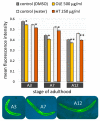Healthspan Maintenance and Prevention of Parkinson's-like Phenotypes with Hydroxytyrosol and Oleuropein Aglycone in C. elegans
- PMID: 32276415
- PMCID: PMC7178172
- DOI: 10.3390/ijms21072588
Healthspan Maintenance and Prevention of Parkinson's-like Phenotypes with Hydroxytyrosol and Oleuropein Aglycone in C. elegans
Abstract
Numerous studies highlighted the beneficial effects of the Mediterranean diet (MD) in maintaining health, especially during ageing. Even neurodegeneration, which is part of the natural ageing process, as well as the foundation of ageing-related neurodegenerative disorders like Alzheimer's and Parkinson's disease (PD), was successfully targeted by MD. In this regard, olive oil and its polyphenolic constituents have received increasing attention in the last years. Thus, this study focuses on two main olive oil polyphenols, hydroxytyrosol (HT) and oleuropein aglycone (OLE), and their effects on ageing symptoms with special attention to PD. In order to avoid long-lasting, expensive, and ethically controversial experiments, the established invertebrate model organism Caenorhabditis elegans was used to test HT and OLE treatments. Interestingly, both polyphenols were able to increase the survival after heat stress, but only HT could prolong the lifespan in unstressed conditions. Furthermore, in aged worms, HT and OLE caused improvements of locomotive behavior and the attenuation of autofluorescence as a marker for ageing. In addition, by using three different C. elegans PD models, HT and OLE were shown i) to enhance locomotion in worms suffering from α-synuclein-expression in muscles or rotenone exposure, ii) to reduce α-synuclein accumulation in muscles cells, and iii) to prevent neurodegeneration in α-synuclein-containing dopaminergic neurons. Hormesis, antioxidative capacities and an activity-boost of the proteasome & phase II detoxifying enzymes are discussed as potential underlying causes for these beneficial effects. Further biological and medical trials are indicated to assess the full potential of HT and OLE and to uncover their mode of action.
Keywords: C. elegans; Parkinson’s disease; ageing; healthspan; lifespan; olive oil; polyphenols.
Conflict of interest statement
The authors declare no conflict of interest.
Figures










Similar articles
-
Healthspan Enhancement by Olive Polyphenols in C. elegans Wild Type and Parkinson's Models.Int J Mol Sci. 2020 May 29;21(11):3893. doi: 10.3390/ijms21113893. Int J Mol Sci. 2020. PMID: 32486023 Free PMC article.
-
EVOO Polyphenols Relieve Synergistically Autophagy Dysregulation in a Cellular Model of Alzheimer's Disease.Int J Mol Sci. 2021 Jul 5;22(13):7225. doi: 10.3390/ijms22137225. Int J Mol Sci. 2021. PMID: 34281279 Free PMC article.
-
Inhibition of human islet amyloid polypeptide aggregation and cellular toxicity by oleuropein and derivatives from olive oil.Int J Biol Macromol. 2020 Nov 1;162:284-300. doi: 10.1016/j.ijbiomac.2020.06.170. Epub 2020 Jun 20. Int J Biol Macromol. 2020. PMID: 32569693
-
Potential Uses of Olive Oil Secoiridoids for the Prevention and Treatment of Cancer: A Narrative Review of Preclinical Studies.Int J Mol Sci. 2021 Jan 27;22(3):1234. doi: 10.3390/ijms22031234. Int J Mol Sci. 2021. PMID: 33513799 Free PMC article. Review.
-
Studying Parkinson's disease using Caenorhabditis elegans models in microfluidic devices.Integr Biol (Camb). 2019 May 1;11(5):186-207. doi: 10.1093/intbio/zyz017. Integr Biol (Camb). 2019. PMID: 31251339 Review.
Cited by
-
Anti-Inflammatory and Neuroprotective Polyphenols Derived from the European Olive Tree, Olea europaea L., in Long COVID and Other Conditions Involving Cognitive Impairment.Int J Mol Sci. 2024 Oct 14;25(20):11040. doi: 10.3390/ijms252011040. Int J Mol Sci. 2024. PMID: 39456822 Free PMC article. Review.
-
Different phenotypes of microglia in animal models of Alzheimer disease.Immun Ageing. 2022 Oct 8;19(1):44. doi: 10.1186/s12979-022-00300-0. Immun Ageing. 2022. PMID: 36209099 Free PMC article. Review.
-
Monitoring the Redox Status in Multiple Sclerosis.Biomedicines. 2020 Oct 12;8(10):406. doi: 10.3390/biomedicines8100406. Biomedicines. 2020. PMID: 33053739 Free PMC article. Review.
-
Extra Virgin Olive Oil Secoiridoids Modulate the Metabolic Activity of Dacarbazine Pre-Treated and Treatment-Naive Melanoma Cells.Molecules. 2022 May 21;27(10):3310. doi: 10.3390/molecules27103310. Molecules. 2022. PMID: 35630786 Free PMC article.
-
Influence of Oleacein, an Olive Oil and Olive Mill Wastewater Phenolic Compound, on Caenorhabditis elegans Longevity and Stress Resistance.Foods. 2024 Jul 5;13(13):2146. doi: 10.3390/foods13132146. Foods. 2024. PMID: 38998651 Free PMC article.
References
-
- Deas E., Cremades N., Angelova P.R., Ludtmann M.H., Yao Z., Chen S., Horrocks M.H., Banushi B., Little D., Devine M.J. Alpha-synuclein oligomers interact with metal ions to induce oxidative stress and neuronal death in Parkinson’s disease. Antioxid. Redox Signal. 2016;24:376–391. doi: 10.1089/ars.2015.6343. - DOI - PMC - PubMed
MeSH terms
Substances
Grants and funding
LinkOut - more resources
Full Text Sources
Medical

